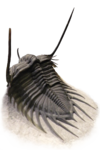Gravicalymene

| Gravicalymene Temporal range:
| |
|---|---|

| |
| Gravicalymene yamakoshii Kobayashi & Hamada, 1977. From the Devonian of Japan. | |
| Scientific classification | |
| Domain: | Eukaryota |
| Kingdom: | Animalia |
| Phylum: | Arthropoda |
| Class: | †Trilobita |
| Order: | †Phacopida |
| Family: | †Calymenidae |
| Genus: | †Gravicalymene |
| Species | |
|
See text. | |
Wikimedia Commons has media related to Gravicalymene.
Gravicalymene Shirley, 1936,[1] is a genus of trilobites belonging to the order Phacopida, suborder Calymenina and family Calymenidae. Species included in this genus have previously been allocated to Calymene Brongniart 1822,[2]Flexicalymene Shirley, 1936. and Sthenarocalymene Siveter 1977.[3]
Rarest within the genus is the Middle Ordovician species Gravicalymene magnotuberculata, which is also amongst the rarest of all Calymenidae and regionally confined to two exposures in New York State. G. magnotuberculata is noted for its extremely pustulose exoskeleton, bell-shaped glabella and lack of complete articulated specimens.
Type species[edit]
- Gravicalymene convolva Shirley 1936, by original designation. Found only in the Birdshill Limestone (Pusgillian or lowest Cautleyan Stage) at Birdshill Quarry, near Llandeilo, South Wales.[4]
Other species[edit]
Some known species and locations include:
- Gravicalymene arcuata Price, 1982. Rawtheyan Stage, Dolhir Formation, Cynwyd Forest Quarry, Denbighshire, North Wales, UK.[5]
- Gravicalymene pontillis Price, 1982. From the upper Cautleyan and lower Rawtheyan of the Berwyn Range and near Conway, North Wales.
- Gravicalymene quadrata (King, 1923), from the Rawtheyan Zone 7 at Craig-Fawr Llanfyllyn and the Meifod area. (see Price, 1982). Transferred to Sthenarocalymene sp. nov. by Siveter (1977, p. 386).
- Gravicalymene praecox Bancroft, 1949,[6][7] from the Smeathen Wood Beds (Harnagian Stage, Reuscholithus reuschi Biozone) near Horderley, Wistanstow, Shropshire, England.
- Gravicalymene jugifera Dean, 1962, from the pusgillian and lowermost Cautleyan in Northern England.[8]
- Gravicalymene inflata Dean, 1963. The only known specimen is from the Onnian Stage, Onnia gracilis Zone, in the north bank of the River Onny, 100 yards east of its junction with Batch Gutter (on the A489 Horderley road, 1 km from its junction with the A49 near Wistanstow, Shropshire).[9]
- Gravicalymene capitovata Siveter, 1977 From the Middle Ordovician of the Oslo Region, Norway.
- Gravicalymene quadrilobata Chatterton 1971. Its type locality is Chatterton Loc. C, Spirifer yassensis Lst, near Yass, NSW, which is in an early Devonian (Emsian) marine limestone in the Taemas Formation of Australia.[10]
- Gravicalymene yamakoshii Kobayashi & Hamada, 1977. From the Devonian of Japan.[11]
- Gravicalymene abbreviata (Foerste, 1910), southwestern Ohio, southeastern Indiana, and northern Kentucky.[12]
- Gravicalymene bakeri (Smith & Ebach, 2020), from Late Ordovician shales of the Gordon Group in northern Tasmania.[13][14] Named after Doctor Who actor Tom Baker.
- Gravicalymene hagani Ross and Barnes, 1967, Lexington Limestone, Salvisa Bed of the Lexington Limestone, 21 feet below base of Clays Ferry Formation. Section 30B (Perryville South), North America.[15] Also Iran.[16]
- Gravicalymene magnotuberculata (Ruedemann, 1926),[17] from 2 localized bedding planes in the Denley Limestone, Trenton Group (Middle Ordovician), Herkimer County, New York State, United States.
- Gravicalymene truncatus Ross, 1979. Only found at its type locality, USGS 7984-CO, along Moffett Road, 0.5 miles west of Kenton, which is in an Edenian offshore ramp packstone/mudstone in the Kope Formation of Kentucky, USA.[18]
References[edit]
- ^ "†Gravicalymene Shirley 1936 (trilobite)". Paleobiology Database. Retrieved 21 August 2011.
- ^ BRONGNIART, A. 1822. Les Trilobites. pp. 1-65, pls. 1-4 in: Histoire Naturelle des Crustacés Fossiles. Paris. F. G. Levrault, Libraire. 154 pp. 11 pls.
- ^ SIVETER, D. J. 1977. The Middle Ordovician of the Oslo Region, Norway, 27. Trilobites of the Family Calymenidae. Norsk Geologisk Tidsskrift 56: 335 - 396.
- ^ SHIRLEY J. 1936. Some British trilobites of the family Calymenidae. Q. J. Geol. Soc. 92 (1–4): 384 – 422.
- ^ PRICE, D. 1982. Calymene quadrata King, 1923 and allied species of trilobites from the Ashgill Series of North Wales. Geological Magazine, Volume 119, Issue 1 , January 1982 , pp. 57 - 66. DOI: https://doi.org/10.1017/S0016756800025656
- ^ BANCROFT, B. B. 1949. Upper Ordovician trilobites of zonal value in south-east Shropshire (Edited by A. Lamont). Proc. R. Soc. (B), 136, pp. 291 - 315, pls. 9 - 11.
- ^ LAMONT, A. 1946. Mr. B. B. Bancroft. Nature 157, p. 42. https://rdcu.be/cfPbu
- ^ DEAN, W. T., 1962. The trilobite faunas of the Caradoc Series in the Cross Fell Inlier of Northern England. Bulletin British. Museum (natural History), Geology, 7 (3) pp. 65 - 134.
- ^ DEAN, W. T., 1963, The Ordovician trilobite faunas of South Shropshire, III; British Mus. Nat. History Bull., Geology, v. 7, no. 8, pp. 215 - 254, pls. 37 - 46.
- ^ CHATTERTON, B. D. E. 1971. Taxonomy and ontogeny of Siluro-Devonian trilobites from near Yass, New South Wales. Palaeontographica Abteilung A 137 (1 - 3): 1 - 10.
- ^ KOBAYASHI, T. & HAMADA, T., 1977. Devonian trilobites of Japan in comparison with Asian, Pacific and other faunas. Palaeontological Society of Japan, Special Papers, no. 20, pp. i–vii + 1–202, pls. 1–13. (Reference No. 0551)
- ^ "Ohio University". Archived from the original on 2011-07-20. Retrieved 2011-01-06.
- ^ Enrico de Lazaro: Fossils of New Trilobite Species Found in Tasmania, on:sci-news, Sep 28, 2020
- ^ SMITH, P. M. & EBACH, M. C. 2020. A new Ordovician (Katian) calymenid, Gravicalymene bakeri sp. nov., from the Gordon Group, Tasmania, Australia. In:: Alcheringa: An Australasian Journal of Palaeontology, published online September 16, 2020; doi:10.1080/03115518.2020.1797874
- ^ ROSS R. J. Jr, BARNES H. 1967. Some Middle Ordovician brachiopods and trilobites from the Basin Ranges, western United States. America: U.S. Govt. Print. Off.
- ^ : Hamed Ameri, Reza Arjmandzadeh & Khalil Ghoorcgi (2019): The peri-Gondwanian Early Silurian trilobites from Kopeh Dagh, Iran, Historical Biology. https://doi.org/10.1080/08912963.2019.1681420
- ^ RUEDEMANN, R. 1926. The Utica and Lorraine Formations of New York. Pt. 2. N. Y. State Mus. Bull. No. 272.
- ^ "Trilobites of eastern North America". Archived from the original on 2011-08-31. Retrieved 2011-01-06.

